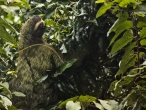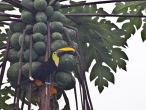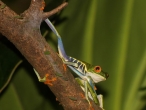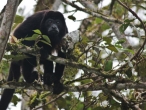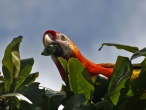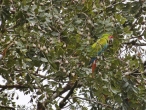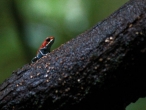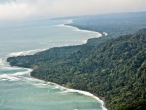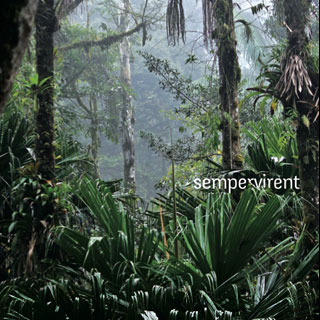
Sempervirent | Rodolphe ALEXIS
Gruen 111| Audio CD > [Sold Out]
MP3 & FLAC > [order]
„Sempervirent“ is a stereo edit of a series of ’sequence-shots‘ where the quadraphonic microphone setup records all that passes by. Some are straight, untouched raw recordings, and others are slightly reworked, but there are no hydrophone, or parabolic recordings (except on track 05).
I spent two months in protected areas of Costa Rica making multichannel field recordings of the different forest ecosystems of Central America. Armed with a quadraphonic setup (IRT cross), a parabolic microphone, a hydrophone, and a scientist’s passport, I went to nine main sites to record: the coastal evergreen forest, the tropical dry and deciduous forest, the mangroves, the wooded riverbanks and floodplains, and the forests altered in cultivated areas. The recordings were made at the Santa Rosa National Park, Caño Negro National Wildlife Refuge, Tortuguero National Park, Sarapiqui (private reserve), Tapanti National Park, La Amistad International Park, Marino Ballenas National Park, Bahia Drake (private reserve) and the Corcovado National Park. An edited version of these recordings exists as a multichannel sound installation and as a live spatialised diffusion : Dry, Wet, Evergreen.
Located on the Mesoamerican Biological Corridor, The Costa Rica is a biodiversity hotspot. Territory refuge for many neotropical species in danger of extinction, the country has moved in just 40 years, from a critical state of deforestation to a radical awareness of environmental issues.
01 Altamira sunset – a bat & a motmot – 4’06
02 at dawn among the river – birds and monkeys – 8’15
MP3
03 the call, the gathering, the storm – mantled howler monkey, orange-fronted parakeet, white-fronted parrot, yellow-naped amazon – 11’43
MP3
04 walking palm’s wet wood – 2’31
05 parabolic amphibian mix (various tree frogs) – 5’52
MP3
06 breakfast on tin roofs – scarlet macaw – 2’17
MP3
07 outside Sirena station – 7’27
08 bats of la Casona – greater white-lined bat and others – 3,31
09 a quiet walk – laughing falcon, white-throated capuchin – 6’08
10 Santa Rosa’s slightly windy night – 6’10
10 Tracks (55′20″)
CD (500 copies)
Identified recorded species:
01 blue-crowned motmot (momotus momota) 02 neotropioc cormorant (phalacrocorax brasilianus), northern jacana (jacana spinosa), little blue heron (egretta caerulea), mantled howler monkey (alouatta palliata) 03 orange-fronted parakeet (aratinga canicularis), white-fronted amazon (amazona albifrons), yellow-naped amazon (amazona auropalliata), thicket tinamou (crypturellus cinnamomeus)
04 granular poison frog (oophaga granulifera) 05 sabinal frog (leptodactylus melanonotus), tink frog (diasporus diastema), tungara frog (engystomops pustulosus) & Mexican white-lipped frog (leptodactylus fragilis), olive tree frog (scinax elaeochroa), canal zone treefrog (hypsiboas rufitelus), volcan barba tree frog (isthmohyla picadoi) 06 scarlet macaw (ara macao) 07 pantless treefrog (dendropsophus ebraccatus), Central American smilisca (smilisca phaeton), olive tree frog (scinax elaeochroa) 08 greater white-lined bat (saccopteryx bilinear) 09 laughing falcon (herpetotheres cachinnans), white-fronted capuchin (cebus albifrons).
Photo credits: Rodolphe Alexis
Field Recording Series by Gruenrekorder
Germany / 2012 / Gruen 111 / LC 09488 / SACEM / EAN: 4050486070703
MASSIMO RICCI | TOUCHING EXTREMES
It is not that arduous to separate the praiseworthy and the unserviceable in the world of location recordings. Rule of thumb: treat any environmental assemblage as an actual composition, and understand how it unfolds and works. The rest is explicated by a splendid phrase by Robert Lynd: “in order to see birds it is necessary to become part of the silence.” Substitute to “birds” the word “life”, and you’re pretty close to the feelings induced by Sempervirent, published in 2012 and retrieved by mere chance inside a box lying in Touching Extremes’ dusty archives. The lone expression coming to mind after subjecting myself to three successive days with this marvel is a somewhat abused “balance of the self”. I’ll just leave it at that; words are not a requisite in most circumstances and I want to remain, first and foremost, one who learns rather than “teaching”; and, in this case, I did learn. A lot.
You can easily read anything about Alexis’ activity as the conceiver of critically acclaimed installations, or check for yourselves the list of animals, natural sources and technical means utilized for composing this gorgeous suite in the heart of Costa Rica’s protected areas; databasing what is manifest in a review is quite futile. Instead, try and approach the record as a concerto: overtures, interludes, main themes, virtuoso soloists, impressive crescendos and quieter segments. In the sphere of principled listening, there is much to acquire from hypothetically non-evolved species passing along signs of existence. A barely whispered awareness – usually departed during the verbal exchanges involving humans – defines echoes and silences, intensified by atmospheric changes or by the endless chant of insects. The qualities of the single voices, their sheer musicality, do the rest: people might be amused by a howler monkey’s grumble and dog-like barks, or astonished by a recording clarity that nearly allows to sniff the forest’s scents when a rainstorm breaks the constitutional calmness. But if forced to choose favorites, the laughing falcon is a creature that, at long last, could make us get the (aural) picture of lyrical synthesis, whereas tree frogs emit pseudo-synthetic signals of which Thomas Lehn would be envious. We feel richer with every new spin.
link
Ed Pinsent | The Sound Projector
Excellent recordings of animal wildlife and the forest environs on Sempervirent (GRUENREKORDER GRUEN 111), made by the field recordist Rodolphe Alexis. He did it in various nature reserves and protected areas of the Costa Rica forests in Central America. His setup was such that he simply wanted to document whatever passed before his mics, but it so happens a large amount of wildlife was captured onto disk as well, and so a list of species has been provided in the package, along with rich colour photographs of same in the booklet. Monkeys, parrots, frogs and bats abound; all of this information was probably added after the recordings were made, but it adds a satisfying sense of completion to the work. Alexis remains justifiably proud of his decision to leave the recordings raw and unprocessed, and what we hear is as close to nature as technology can bring us. If I had to locate this within the broad spectrum of field recordings, I’d venture to place it at the “scientific investigation” end rather than in the zone of “art music”, but it remains a vivid and fascinating listen. From 18 June 2012.
Curt Cuisine | skug – Journal für Musik
Alles wie gehabt auf dem Gruenrekorder-Label. Auf »Sempervirent« ging Fieldrecordings-Artist Rodolphe Alexis nach Costa Rica, um zwei Monate lang Klangsamples aus dem Regenwald aufzunehmen, überwiegend Tiergeräusche. Die Klangqualität ist hervorragend, die Auswahl stimmig (ich mag den »olive tree frog« und den »laughing falcon«) – und mehr gibt es dazu eigentlich nicht zu sagen. Für nicht genreaffine HörerInnen vielleicht zwei Einsteigertipps: Man kann »Sempervirent« alleine in der Finsternis (möglichst ohne störenden Lärm) anhören. Dann wird das zu einem großartigen Lauschtrip durch den Regenwald. Oder man setzt sich zu einem Spielabend zusammen und versucht die Tierarten zu erraten. Könnte auch witzig sein. Ein Gruenrekorder-Sampler wäre vielleicht sogar der Partyknaller.
Aurelio Cianciotta | Neural
In this release for Gruenrekorder, Rodolphe Alexis, a Parisian experimental sound artist and designer, accustomed to the manipulation of field recordings and meticulous editing, has created stereo sequences using parabolic quadraphonic microphones. These recordings were captured mainly in parks , forests and natural reserves in Costa Rica and surrounding Central American countries. They are sometimes left in their original state and sometimes processed. Besides being used for this album, other versions have been used to enrich multichannel sound installations or spatialized real time emissions. There is a strong biodiversity in the areas visited: a union of ecosystems rich in animal and plant species, some of them on the verge of extinction. Thus, the flow is dominated by a variety of natural sounds: crickets, screaming monkeys, exotic birds, frogs and insects. The artist has tuned in to the most unusual sounds, stressing the extreme richness and variety, and benefitting from the attention paid to environmental issues by the authorities of the countries involved. The habitats are still strongly impacted by human activities, but here this influence seems to disappear and the spotlight is on specific ecological niches. The ten recordings were collected in just two months and describe the passing of days in the passages of sounds and latitudes, making clear the quality and peculiarities of the contexts investigated.
Gruenrekorder have been kindly passing their wonderful array of field recordings my way for a little while now. They have for the most part been exceptional. This one continues that run with a set recorded in the national parks, wildlife refuges and private reserves of Costa Rica.
The recordings are, and I quote the sleeve here, ‘a series of ‘sequence shots’ where the quadraphonic microphone setup records all that passes by’. The soundworld captured is one of dizzying complexity and exotic mystery. Bats, parrots, monkeys, macaws, frogs and more are detailed in a variety of settings, some in as natural an environment as a reflexive observer can observe – ‘At Dawn Among The River’ – whilst others reflect the interplay of animals and humanity – the scarlet macaw eating his ‘Breakfast on Tin Roofs’.
It is a sumptuous album. A soundworld quite literally filled with life. When it’s done well I love this sort of unadorned field recording and here it’s done very well indeed.
Guillermo Escudero | LOOP
Rodolphe Alexis in a sound recordist, sound artist and designer form France who lives and works in Paris. His work is based on field recording, electroacoustic composition, radio pieces and site-specific installations or performances.
In 2003, along with Valérie Vivancos formed OttoannA with several sound works and performances in different parts of Europe. Their debut album ‚l’Arlesienne!‘ comprises 7 years of works.
Alexis spent two months in the protected areas of Costa Rica making multichannel field recordings in different forest ecosystems of Central America. He worked with a set quadraphonic (IRT cross), a parabolic microphone, hydrophone, holding a scientific passport. The sounds were recorded in the national parks of Santa Rosa, Tortuguero, Tapanti, Corcovado, Marino Ballenas, La Amistad International Park, Caño Negro National Wildlife Refuge, private reserves of Sarapiqui and Bahía Drake.
This is a trip into the rainforest where thousands of birds and wildlife animals live in a different climatic environment: abundant and lush green, tropical dry forest, mangroves, wooded riverbanks, floodplains and the forests altered in cultivated areas.
Jean Dezert | Les maîtres fous
La richesse sonore de la forêt tropicale a fasciné les artistes et les audio-naturalistes au point de susciter nombre d’enregistrements. Dans une histoire qui laisserait de côté les disques purement opportunistes, il faudrait citer les incontournables Sounds of a Tropical Rain Forest in America (édité en 1952 chez Folkways), Ambiances de Papouasie de Jean C. Roché (1993), Viva La Selva! de Natasha Barrett (1999), La Selva de Francisco López (1999) ou encore les Rainforest Soundwalks de Steven Feld (2002). A cette liste non exhaustive où se côtoient compositions à la limite de l’abstraction et restitutions d’ambiances, on peut désormais ajouter le tout récent Sempervirent du Français Rodolphe Alexis, paru chez Gruenrekorder.
En novembre et décembre 2011, l’artiste a travaillé dans différentes zones protégées du Costa Rica afin d’y capter images et sons de la forêt. Sur les dix pistes qui composent l’album, Alexis se fait passeur. Son intervention se résume en effet à un travail d’édition minimal. L’essentiel s’est passé sur le terrain où le preneur de sons a réussi à surprendre le maelström biologique si bien décrit par Edward O. Wilson dans son essai Biophilie (dont on publiait un extrait ici). Dans le cas précis de Sempervirent, maelström ne sous-entend pas pour autant vacarme. Rodolphe Alexis a en effet privilégié des ambiances plutôt apaisées où les chants d’amphibiens, cris de singes hurleurs et de perroquets alternent avec quiétude malgré la montée en puissance d’un orage. Sempervirent est un terme de botanique qui signifie ‚toujours vert‘ et désigne donc des forêts aux arbres toujours couverts de feuilles. On apprécie cette idée de permanence que communique l’écoute du disque. Durant la dernière piste, un vent léger évolue tandis que des cigales émettent leur chant nocturne. Ces quelque cinq minutes garantissent ainsi un engourdissement que l’on voudrait prolonger. Les photographies ci-dessus sont également issues de la mission de Rodolphe Alexis.
Born in France in 1975, Rodolphe Alexis brings a pronounced environmental focus to his work, specifically with respect to how the environment is affected by human activity. He’s a man of many projects: not only does his own work encompass field recordings, electro-acoustic composition, radio pieces, and site-specific installations, he’s also one-half of OttoannA, a sound performance duo with Valérie Vivancos (whose debut album is set for imminent release), and a co-founder (with Vivancos) of Double-Entendre, a non-profit organization that has to date published the work of forty-two international sound artists. Sempervirent, Alexis’s contribution to Gruenrekorder’s Field Recording Series, melds both untouched and slightly reworked field recordings into a series of ‘sequence-shots‘ of Costa Rica’s forest ecosystems. Nine main sites, by name Santa Rosa National Park, Caño Negro National Wildlife Refuge, Tortuguero National Park, Sarapiqui (private reserve), Tapanti National Park, La Amistad International Park, Marino Ballenas National Park, Bahia Drake (private reserve) and the Corcovado National Park), were visited in order to document activity within various forests (coastal evergreen, tropical dry, and deciduous), mangroves, and wooded riverbanks and floodplains.
The fifty-five-minute recording is ultimately more a portrait of the species inhabiting the sites than the sites themselves (even if clear changes in weather are sometimes apparent). Every one of its ten settings is earmarked by a distinctive cry or call, whether it be a mantled howler monkey, olive tree frog, scarlet macaw, or greater white-lined bat. Alexis has sequenced the recordings so that they span a full day from an Altamira sunset and riverside dawn to a Santa Rosa night. The sound of footsteps creates the impression of a recorder moving from one location to another, experiencing the different species at each of the sites. As two representative examples, “At Dawn Among the River” and “The Call, the Gathering, the Storm” feature contrasting vocalizations that are striking (the mantled howler monkey’s especially), and the constant flow of grunts, calls, barks, whistles, and chirps evokes a remarkable sense of place for the listener. In the latter piece, thunder and rain temporarily silence the creatures‘ chatter (presumably they’ve all taken shelter or run for cover), but that’s a rare occurrence on a recording that largely positions them front and center. For listeners so inclined, the recording’s an educational listen, too. “Parabolic Amphibian Mix,” for example, offers a single-handed lesson in tree frog varieties, with the sabinal, tink, tungara, Mexican white-lipped, olive tree, canal zone, and volcan barba all making appearances. Mention also should be made of Gruenrekorder’s elaborate packaging, in particular the twelve-page booklet whose colour photographs complement the aural content by providing images of the various species, including the mantled howler monkey and scarlet macaw. There’s a subtle ecological dimension to the recording as well, given that the Costa Rica sites are now territory refuges for many neo-tropical species in danger of extinction. Sempervirent teems with life in a way that enhances one’s awareness of how invaluable such sites can be to the preservation of endangered wildlife.
maeror3 | livejournal
Конечно, этот альбом – не музыкальное произведение, это фиксация звуков окружающего нас мира, призванная, в данном случае, показать нам неописуемое количество форм жизни, населяющих территорию Коста-Рики, и, в то же время, привлечь наше внимание к проблемам вырубки тропических лесов, завоеванию человеком места у природы, в результате чего гибнут многие виды растений, животных и насекомых. Так что француз Рудольф Алексис никакой не музыкант, он ученый, который провел несколько месяцев в национальных парках этой самой маленькой страны в Центральной Америке, с присущей ученым скрупулезностью фиксируя с помощью системы квадрофонических микрофонов, а также гидрофона и параболического микрофона атмосферу джунглей, болот, прибрежных лесов, составляя звуковой атлас уникальных природных локаций.
За редким исключением треки не подвергались обработке, у нас есть возможность услышать те же звуки, которые слышал Алексис, расставивший микрофоны вокруг исследовательских станций, посреди лесных чащ и болот. Для того, чтобы слушатель мог не только сконцентрировать внимание на звуковой ауре местности, диск «Sempervirent» дополнен красочным буклетом, содержащим фотографии множества животных, рептилий и насекомых, голоса которых мы слышим здесь в разных обстоятельствах: на земле, под водой, под полуденным душным пологом джунглей, в относительной ночной тишине, в закатном сумраке или же под потоками проливного тропического дождя. Так что лучше всего слушать этот диск и разглядывать эти снимки – ощущение присутствия (и без того усиленное объемным, «трехмерным», полностью погружающим в себя звучанием этого релиза) будет практически полным. А крики обезьян, пение ярких попугаев и сотен других птиц, кваканье лягушек, стрекот насекомых, оказывается, может быть очень разнообразными и интересными, порой братья меньшие способны издавать звуки за гранью возможностей нашего слуха и воспроизводящей аппаратуры. Будет жаль, если все это однажды исчезнет – лучше уж пусть этот диск со временем не приобретет научной ценности, как «содержащий свидетельства существования ныне полностью вымерших видов», зато мир будет открыт нам во всем своем многообразии, которое можно не только послушать, но и увидеть вживую.
Héctor Cabrero | Le son du grisli
Au dos de la carte postale sonore, je lis le nom du pays d’où elle m’arrive, le Costa Rica, et le nom de son expéditeur, Rodolphe Alexis. Lui a passé deux mois là-bas à enregistrer et photographier la faune et la flore (à chaque bruit de Sempervirent, le livret permet d’associer une forme et un nom). Moi qui ignore tout de la nature qui m’entoure, me voici plongé dans celle qui vit à plusieurs milliers de kilomètres (le site de Gruenrekorder en offre en aperçu en noms et en images, en plus d’extraits de l’enregistrement).
J’en éprouve moins de gêne à ignorer le nom des oiseaux, singes, quadrupèdes, plantes, arbres, que j’entends sur le CD. Ils viennent pourtant bouleverser mon quotidien. Près d’une rivière, dans une mangrove ou dans la forêt tropicale, micro parabolique en main, Rodolphe Alexis a attrapé tout un petit monde, en réalité tout un univers. Il suit une ligne de conduite qui va désépaississant et qui résiste à l’orage, aux pluies diluviennes, au tonnerre, au même titre que les messages codés d’une nature merveilleuse. Qui respire près de moi, qui suis pourtant à plusieurs milliers de kilomètres.
Dan Warburton | Paris Transatlantic Magazine
Listening to field recordings is like looking at someone else’s holiday photographs; they may be very pretty but they’ll never mean as much to you as they do to the person who took them. If acoustic ecology is your thing, though, you’ll probably like these dispatches from the dry, wet and evergreen forests of Costa Rica. Personally, while in the past I’ve enjoyed hydrophone recordings of beasties lurking under Antarctic icebergs and bugs bubbling in Irish bogs, I wonder what grunting, farting mantled howler monkeys (alouatta palliata, in case you’re interested – I’m not) and a tree full of peeping frogs are doing here in the middle of Paris. I can find other tropical rainforests here too if I scout about. I’ve still got a copy of La Selva somewhere, and I don’t listen to that very much either.
„A stereo edit of a series of ’sequence-shots‘ where the quadrophonic microphone setup records all that passes by. Some are straight, untouched raw recordings, and others are slightly reworked,“ is how French sound artist Rodolphe Alexis describes his work, but there are more interesting things on offer over at his website http://www.rodolphe-alexis.info/, my favourite being an installation called Growl’s Growlth, in which he records what happens when a handful of maggots are locked inside a perspex box with 300g of meat and allowed get on with it, buzzing their life away. Mercifully, the excerpt lasts just under two minutes, which is about the right duration for stuff like this. Ask Chris Watson.
Idwal Fisher | IDWAL FISHER
Having not seen a cloud for a week it was a bit of a disappointment to land at Manchester Airport to find that every raincloud in the northern hemisphere had decided to have an outing in the north of England. Driving home in torrential rain over Saddleworth Moor, in an old car, with damp points, at a speed the Victorians would have considered cautious soon had me wondering if I’d hallucinated the 35C heat I’d felt on my skin only a few hours previously.
For our yearly trip to the sunny isle I took with me, for the benefit of my edification, Simon Reynold’s new book ‘Retromania’ and the recent translation of Gunter Grass’s ‘The Tin Drum’ [a book I’d read in my teens and one I’ve been wanting to revisit for a while now]. The recent R4 adaptation of James Joyce’s Ulysses was on the ipod as was Robert Wyatt’s 1997 release ‘Shleep’ an album I’ve been curiously drawn to of late. Has luck would have it appeared in one of those most serendipitous moments courtesy of the shuffle function whilst crossing the waters from Corfu to Paxos all tired and warm and undulating and with a great feeling of knowing that in the not too distant future I‘d be sat outside a welcoming taverna with a well chilled liter of wine to go at.
At home the week previous the idea struck me that it would be a good idea to take some Gruenrekorder along with me. The long, listless afternoons are perfect for soaking up field recording vibes and so it proved. My only problem was that without a serious pair of noise cancelation headphones I discovered that the outside world found a way of creeping in on my own preferred Gruenrekorder one. With these outside sounds consisting of nothing more than cicadas and the odd passing vehicle it wasn’t as if I was competing with a radio pumping rebetika and a neighbor blaring eurotrash through a bust up stereo.
Cicadas are all over Rodolphe Alexis’s ‘Sempervirent’, at least they sound like cicadas. After spending what must have been two uncomfortable months with a quadraphonic parabolic recorder in the heart of the Costa Rican jungle Rodolphie returned to appear with 55 minutes worth here and an installation called ‘Dry, Wet, Evergreen’ which I think showed in France earlier this year. Consisting of a series of ‘sequence shots’, where Alexis edits his quad recordings down to stereo [and on track five mixes in some amphibian sounds with the aid of a hydrophone] Sempervirent proves to be an extraordinary listen. Even whilst indulging on I-suppose-it’ll-have-to-do MP3 the vibrant sounds of the indigenous wildlife burst into my shell-likes with an ability to transport me from the dusty olive groves of Paxos to the lush interiors of the Costa Rican jungle. Everything from birds, to monkeys to frogs and insects are captured, as are Alexi’s own footsteps and the sound of rain hitting a tin roof from where he shelters. Perhaps most remarkable of all is the sound of the mantled howler monkey declaring his presence to a new day with naught but a barely discernible hum of insects and the slowly awakening chatter of birds for company – a sound that goes to show that nature can delight the ears as much as any man-made sound – all this on track three, the longest on offer at 11 minutes and one that ends with a terrific thunderstorm. Listening to this through state of the art reproduction equipment must be an even more remarkable experience [just don’t ask me to go and hear all this first hand, I like my comfort too much].
Works like ‘Sempervirent’ [meaning verdant] not only show how diverse a wildlife we have in such places they act as markers for the future. With natural habitat disappearing at ever faster rates it’d be interesting to compare a recording made ten years hence with what Alexis has recorded here. Besides being incredible listening experience Sempervirent exists as hard evidence for naturalists and eco campaigners alike.
Field recordings made in jungles aren’t anything new of course, Gruenrekorder have further examples in their catalogue [and David Tudor even went so far as to create his own] but none on Autumn Leaves another release that tumbled in and out of my consciousness over a long hot week. Or maybe there was? I have to admit to having the odd nod whilst listening to these 33 tracks and three plus hours worth of sounds but what I heard I enjoyed – as I did the last Gruenrekorder comp that came this way [Playing With Words].
Here I reacquainted myself with Aki Onda, a Japanese artist resident in New York whose cassette recordings of the city form the basis of his ongoing ‘Cassette Memories’ project. I saw him last year at Colour Out Of Space in Brighton, one of the few highlights of the weekend – lots of bird sounds emerging from traffic, buskers, passing radios, something that John Levack Drever mirrors with his ‘Phonographies of Glasgow’. There’s a ten minute interview with Chris Watson and some amazing sounds from Finland where pebbles are thrown across a frozen lake. John Wynne’s track ‘Someone Else Has Died’ contains reminiscences of drug addicts matched to floating like synth sounds, a short work [an edit] that sounds remarkably similar in structure to the Delia Derbyshire/Barry Bermagne’s ‘Dream’ project for the BBC. Ethnography and field recordings sit comfortably over of aural entertainment and its all free. A perfect gateway to Gruenrekorder land.
Frans de Waard | VITAL WEEKLY
Not the first one to capture the rain forest in Costa Rica, I should think, and I never heard of Rodolphe Alexis. He records with a quadraphonic microphone which records everything that passes by. ‚Some are straight, untouched raw recordings, and others are slightly reworked, but there are no hydrophone, or parabolic recordings (except on track 05)‘. Perhaps Alexis moves in circles where such information is of vital interest, I don’t know. Like with many of such releases on Gruenrekorder, I have a hard time reviewing them. Perhaps because I find it hard to judge them purely on a musical level, which I realize more and more is my main interest. Collections with field recordings like this, of countries I haven’t visited, are things I can hear with interest, but hardly think of as great music – and yes, perhaps that doesn’t make me another John Cage, assuming each sound is interesting. I am sure each sound is interesting, but even more interesting if you do something with it. With releases like this, I like to take those sounds and do something with that, perhaps try and create some nice music out of it. I can hear that its all well recorded, and perhaps from a biologist view interesting, but I am not a biologist either.
Cheryl Tipp | The Field Reporter
‘Sempervirent’ is the result of fieldwork conducted in various protected areas of Costa Rica by French sound artist Rodolphe Alexis. The collection of 10 field recordings, gathered over a 2 month period, gives the listener a taste of the different natural soundscapes that exist within the forest ecosystems of Central America.
Central and South American forests have been the inspiration behind many a publication. It seems almost natural though, that a field recordist would be drawn to these biomes which, all being well, are heaving with biodiversity both visually and aurally. Alexis, like many before him (and doubtless many after), saw the acoustic potential and headed to Costa Rica armed with a quadraphonic microphone array, a parabolic microphone, a hydrophone and, most importantly, a scientist’s passport.
Multichannel recordings were made in the field, but, for the purposes of this release, were transformed into standard stereo edits that provide a series of “sequence-shots” from different wildlife refuges, parks and local reserves. The full effect of these recordings in their original form can be experienced through live performances and the multichannel installation Dry, Wet, Evergreen.
It’s difficult to choose, but one of the “stand-out” tracks has to be ‘at dawn among the river’. The stereo image created here is superb. Set against a backdrop of insects, birds and the gentle trickle of the nearby river, Mantled Howler Monkeys soon come into voice. At one point it feels as if a howler monkey is literally perched on your left shoulder, calling to others across the forest canopy.
If I had to describe ‘Sempervirent’ in one word, it would be “calm”. A definite feeling of tranquillity and peace is cast over the listener during the duration of this publication. The recordings are understated, though not in the least boring or devoid of interest. What I mean is that the listener is not thrown headfirst into a sea of sound, where bird, mammal, amphibian and insect voices all come together in what can be an amazing, but sometimes overwhelming, cacophony.
Each track brings something new for the listener to enjoy; a crucial skill when it comes to compiling a selection of individual recordings. In addition to species recordings, ‘Sempervirent’ also points its microphone at the surrounding geophony. Towards the end of track 3, a chorus of parrots is gradually overshadowed by the approach of a thunderstorm. The patter of falling rain over the forest is accompanied by cracking thunderclaps and is a definite highlight for me.
As is always the case with Gruenrekorder, the packaging and artwork is wonderful. The accompanying booklet features an assortment of photographs from the recording locations and provides a visual point of reference when listening to the soundscapes.
As a lover of natural field recordings in their purest form, it’s just wonderful for me to see this publication added to Gruenrekorder’s growing catalogue. As with the recent Peter Caeldries offering, ‘Jhirna Jali’ (Gruenrekorder GrDI 107), ‘Sempervirent’ uses sound to celebrate some of our planet’s remaining “wild places”. Here the ever-invading presence of the 21st century can be left behind, giving us as listeners the opportunity to experience soundscapes that have been in existence long before the dawn of humankind.
Rodolphe ALEXIS | Sempervirent @ The Wire On Air
Adventures In Sound And Music 5 July 2012
Listen to ‚Adventures In Sound And Music 5 July 2012‘ (Stream)


